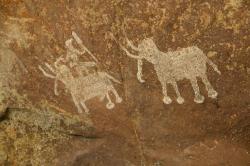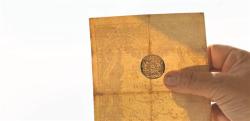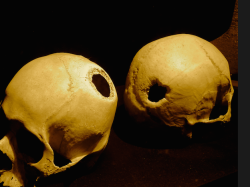INSTITUT SUPERIEUR D'ANTHROPOLOGIE
INSTITUTE OF ANTHROPOLOGY
ONLINE COURSES / COURS A DISTANCE
FALL TERM : OCTOBER 2015
REGISTER NOW
INDE –  Raisen - The Madhya Pradesh directorate of archaeology, archives and museums has drawn up a plan to conserve and further explore the huge ancient wall and other related remains discovered last year in neighbouring Raisen district. The department has also shared a detailed survey report on the wall with the MP Tourism Development Corporation (MPTDC), which is expected to soon analyse the tourism potential of the site, officials have said. HT had first reported the discovery of a huge stone wall, considered to have been constructed around 10th/11th century AD last year, after which the state directorate of archaeology had taken up a detailed survey on the wall and other archaeological remains found in the vicinity. The wall and other remains were discovered by history enthusiasts associated with Bharatiya Itihas Sankalan Samiti, Raisen and with technical help of prominent archaeologist Narayan Vyas. Vyas told HT that among the remains are those of many Parmar era (10th-12th century) temples dedicated to various Hindu deities and a massive man-made pond with red sandstone fitted banks. Deputy director (archaeology) DK Mathur told HT that the initial survey has been completed and a plan has been drawn for conservation and further exploration of the remains.
Raisen - The Madhya Pradesh directorate of archaeology, archives and museums has drawn up a plan to conserve and further explore the huge ancient wall and other related remains discovered last year in neighbouring Raisen district. The department has also shared a detailed survey report on the wall with the MP Tourism Development Corporation (MPTDC), which is expected to soon analyse the tourism potential of the site, officials have said. HT had first reported the discovery of a huge stone wall, considered to have been constructed around 10th/11th century AD last year, after which the state directorate of archaeology had taken up a detailed survey on the wall and other archaeological remains found in the vicinity. The wall and other remains were discovered by history enthusiasts associated with Bharatiya Itihas Sankalan Samiti, Raisen and with technical help of prominent archaeologist Narayan Vyas. Vyas told HT that among the remains are those of many Parmar era (10th-12th century) temples dedicated to various Hindu deities and a massive man-made pond with red sandstone fitted banks. Deputy director (archaeology) DK Mathur told HT that the initial survey has been completed and a plan has been drawn for conservation and further exploration of the remains.
http://www.nyoooz.com/bhopal/115786/conservation-further-exploration-on-anvil-for-great-wall-of-raisen
INDE – Thrikkanamathilakom - With the completion of the first phase of excavation at Thrikkanamathilakom in Thrissur, there emerged evidence that could possibly justify the existence of a Jain temple rumoured to have endured the 12th century. According to the archaeological team, the evidence regarding the Jain temple is by no means conclusive, but they have discovered the remnants of a high wall bearing a striking resemblance to the one that might have existed in such a temple in that era. “The excavation team has discovered pieces of ‘Marottu’, the kind of roofing systems seen in temples upto 12th century. They have also discovered coins used in the era of Chera rule, ancient iron needles and remnants of an ancient temple wall,” said MLA V S Sunilkumar. What is even more mysterious, according to the excavation team, is that the 12th century temple, the existence of which they have confirmed, was destroyed by an external force. “Some locations of the temple, which we have discovered, bear signs of having come under attack by an external agent. How it happened can only be understood after we get a clearer picture of what the building used to be,” B Mohanachandran of the Archaeology Department, who is in charge of the dig said. There have been literal versions of the existence of a Jain temple in Mathilakom, corroborated by the inscriptions found near Pulpally in Wayanad which is considered as the major entry point of Jainist monks into Kerala. The engravings have described Thrikkanamathilakom temple as a ‘model’ Jain centre. The temple in Thrikkanamathilakom has also been rumoured to be the home of ‘Digambara’ or sky clad sect of Jains, characterised by their complete nakedness, a traditional umbrella made of fallen peacock feathers and a perpetual clothing over their mouth. The archaeological team refutes the arguments that the site was destroyed during Tipu Sultan’s military regime, as some historians have suggested. “The upper caste Hindus or the Brahmins were not allowed entry into the temple and this might have resulted in a fight that brought down the site. The temple at Kodungalloor used to be a Buddhist place of worship and Koodalmanikyam was believed to have been a Jain temple earlier,” said members of the excavation team.
http://www.newindianexpress.com/states/kerala/Remnants-of-Jain-Temple-Found-at-Mathilakom/2015/05/31/article2841375.ece
INDE –  Gawilgarh hills - The Archaeological Survey of India (ASI) has completed the excavation work of decorated rock shelters in the Gawilgarh hills in the Betul district in Satpuda ranges in Madhya Pradesh. The survey explored a stretch of 40km in the hills and found total 247 shelters since excavations first started in 2012-13. ASI is yet to date the period to which these shelters belong. However, based on the rock paintings and engravings in these shelters they tentatively range from the upper palaeolithic period (late stone age-50,000 to 10,000 years ago) to modern time through the stone age (mesolithic period) and chalcolithic (copper/metal) age and historical period.
Gawilgarh hills - The Archaeological Survey of India (ASI) has completed the excavation work of decorated rock shelters in the Gawilgarh hills in the Betul district in Satpuda ranges in Madhya Pradesh. The survey explored a stretch of 40km in the hills and found total 247 shelters since excavations first started in 2012-13. ASI is yet to date the period to which these shelters belong. However, based on the rock paintings and engravings in these shelters they tentatively range from the upper palaeolithic period (late stone age-50,000 to 10,000 years ago) to modern time through the stone age (mesolithic period) and chalcolithic (copper/metal) age and historical period.
http://timesofindia.indiatimes.com/city/nagpur/ASI-discovers-247-rock-shelters-at-Gawilgarh-hills/articleshow/47476216.cms
ROYAUME UNI –  Flint - Eight hundred year old defences that once protected medieval Flint have been discovered during an archaeological dig in Flint. The excavation at Coleshill Street has also unearthed pottery dating back to the 17th century and a tobacco pipe thought to be from the 19th century. Experts from Archaeology Wales have been working at the former maisonnette site for the last fortnight ahead of the town centre’s major redevelopment. A team of archaeologists will be on-site until the end of August and hope to find even more artefacts dating back to the 13th century. Flint Castle and the fortified town were the first to be built in Wales by Edward I of England in 1277. The town was enclosed by double banks and ditches to protect it from Prince of Wales Llewelyn ap Gruffydd’s troops. Archaeology Wales project manager Kate Pitt told the Daily Post: “The site is known to be within the medieval town and across the site we’ve got the 13th century bank and ditch from Edward’s defended town linked to Flint Castle.” Kate said: “It appears that the ditch is cut quite steeply downwards, as you would expect for a defensive ditch, making it much harder to cross and attack the town. “The lower fills of the ditch are of red sandy-silt clay, which may indicate the ditch was filled with tidal water, similarly to the moat around Flint Castle itself.”
Flint - Eight hundred year old defences that once protected medieval Flint have been discovered during an archaeological dig in Flint. The excavation at Coleshill Street has also unearthed pottery dating back to the 17th century and a tobacco pipe thought to be from the 19th century. Experts from Archaeology Wales have been working at the former maisonnette site for the last fortnight ahead of the town centre’s major redevelopment. A team of archaeologists will be on-site until the end of August and hope to find even more artefacts dating back to the 13th century. Flint Castle and the fortified town were the first to be built in Wales by Edward I of England in 1277. The town was enclosed by double banks and ditches to protect it from Prince of Wales Llewelyn ap Gruffydd’s troops. Archaeology Wales project manager Kate Pitt told the Daily Post: “The site is known to be within the medieval town and across the site we’ve got the 13th century bank and ditch from Edward’s defended town linked to Flint Castle.” Kate said: “It appears that the ditch is cut quite steeply downwards, as you would expect for a defensive ditch, making it much harder to cross and attack the town. “The lower fills of the ditch are of red sandy-silt clay, which may indicate the ditch was filled with tidal water, similarly to the moat around Flint Castle itself.”
VIDEO = http://www.dailypost.co.uk/news/north-wales-news/watch-flint-archaeological-dig-unearths-9355289
TURQUIE –  - A 50-kuruş, watermarked Ottoman banknote, the existence of which has been discussed for more than a century, has been found among banknotes sent by a collector for valuation. The banknote is dated 1876. Numismatist Mehmet Tezçakın, a consultant to a London-based international auction company, said that a collector based in Germany had sent him some Ottoman banknotes for valuation. About examining the banknote and seeing the watermark, Tezçakın said, “I was very excited when I saw it. It has been said for more than a century that watermarked-banknotes were printed in the Ottoman era but we have never found them. All numismatists in the world want to have this banknote. Watermarking was forbidden in the Ottoman era due to religion the; that is why it cannot be seen in other banknotes…Under the light, it is seen that this banknote has a crescent-shaped-moon portrait. Its nose and eyebrows resemble Abdulhamid II.” He said that with the permission of the collector in Germany, he has publicized the banknote. “This priceless piece will be put up for sale abroad soon. Particularly, U.S., Arab and Israeli collectors will show interest in it. This most valuable banknote of Turkish finance history should be brought to Turkey and displayed at a monetary museum,” he added.
- A 50-kuruş, watermarked Ottoman banknote, the existence of which has been discussed for more than a century, has been found among banknotes sent by a collector for valuation. The banknote is dated 1876. Numismatist Mehmet Tezçakın, a consultant to a London-based international auction company, said that a collector based in Germany had sent him some Ottoman banknotes for valuation. About examining the banknote and seeing the watermark, Tezçakın said, “I was very excited when I saw it. It has been said for more than a century that watermarked-banknotes were printed in the Ottoman era but we have never found them. All numismatists in the world want to have this banknote. Watermarking was forbidden in the Ottoman era due to religion the; that is why it cannot be seen in other banknotes…Under the light, it is seen that this banknote has a crescent-shaped-moon portrait. Its nose and eyebrows resemble Abdulhamid II.” He said that with the permission of the collector in Germany, he has publicized the banknote. “This priceless piece will be put up for sale abroad soon. Particularly, U.S., Arab and Israeli collectors will show interest in it. This most valuable banknote of Turkish finance history should be brought to Turkey and displayed at a monetary museum,” he added.
http://www.hurriyetdailynews.com/long-lost-watermarked-ottoman-banknote-found-.aspx?pageID=238&nid=83190&NewsCatID=375
PEROU –  - Using forensic tools, a team of anthropologists in the United States has shown that ancient Peruvians were much more diverse than previously thought. The team analysed the skulls of people living before the Spanish Conquest for tiny but significant differences. The finding may make scientists rethink ideas about people migrated to South America in the distant past. Forensic examination of skeletal remains is a powerful tool in New World archaeology; allowing scientists to get a better handle on where people came from and how they interacted. “For a long time, the conventional wisdom was that there was very little variation prior to European contact,” said Ann Ross, a forensic anthropologist at North Carolina State University and co-author of the study. “Our work shows that there was actually significant variation.” Ross and the team looked particularly at the facial features of more than 500 skulls from the Yauyos, Ancon, Cajamarca, Jahuay, Makatampu, Malabrigo, and Pacatnamu peoples. These cultures flourished between the first and fifteenth centuries. “The Yauyos had facial features that were very different even from other peoples in the same region,” said Ross. As might be expected, the greater the distance between peoples, the greater the difference. It is not known precisely just how many people lived in Peru before Pizarro but the Inca empire is thought to have had a population between 10 and 12 million. Upwards of 90 per cent of aboriginal people died in the decades immediately after the Conquest, mainly from disease.
- Using forensic tools, a team of anthropologists in the United States has shown that ancient Peruvians were much more diverse than previously thought. The team analysed the skulls of people living before the Spanish Conquest for tiny but significant differences. The finding may make scientists rethink ideas about people migrated to South America in the distant past. Forensic examination of skeletal remains is a powerful tool in New World archaeology; allowing scientists to get a better handle on where people came from and how they interacted. “For a long time, the conventional wisdom was that there was very little variation prior to European contact,” said Ann Ross, a forensic anthropologist at North Carolina State University and co-author of the study. “Our work shows that there was actually significant variation.” Ross and the team looked particularly at the facial features of more than 500 skulls from the Yauyos, Ancon, Cajamarca, Jahuay, Makatampu, Malabrigo, and Pacatnamu peoples. These cultures flourished between the first and fifteenth centuries. “The Yauyos had facial features that were very different even from other peoples in the same region,” said Ross. As might be expected, the greater the distance between peoples, the greater the difference. It is not known precisely just how many people lived in Peru before Pizarro but the Inca empire is thought to have had a population between 10 and 12 million. Upwards of 90 per cent of aboriginal people died in the decades immediately after the Conquest, mainly from disease.
http://www.peruthisweek.com/news-scientists-find-ancient-peruvians-more-diverse-than-first-thought-106397
INDE – Naurgangabad - As many as 489 old coins of copper have been found in Naurgangabad village of Bhiwani district which are believed to be linked to the Mauryan dynasty. The Archaeological Survey of India on Friday deputed an official to visit the site where the coins were found on May 27. Superintending archaeologist of ASI's Chandigarh circle, G N Srivastava, told TOI that they would collect details about the recoveries as the land where coins were found belonged to a villager. A portion of the village land has already been declared as protected site by the ASI. Earlier, the surface explorations had yielded a large number of coins, coin-moulds, seals and sealing of different Kings of historical period including those of Yaudheya, Indo-Greek, Kushana and Gupta periods. The villagers feel that the latest coins belong to Maurya dynasty stating that the pictures on the currency resemble features of Mauryan king Ashoka. The archaeologists are yet to examine the coins but Srivastava said that they have previously recovered remains of pre-Maurya era also from the village. According to archaeologists, they have already found some remains related to king Ashoka in neighbouring areas like Hisar and Fatehabad. A Buddhist Stupa at village of Chaneti in Yamunanagar district also belongs to the Mauryan king.
http://timesofindia.indiatimes.com/india/489-coins-dating-back-to-Mauryan-era-found-in-Bhiwani-village/articleshow/47477749.cms